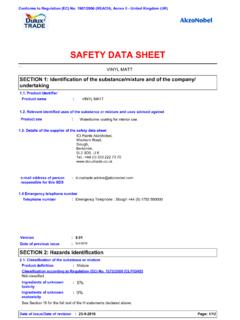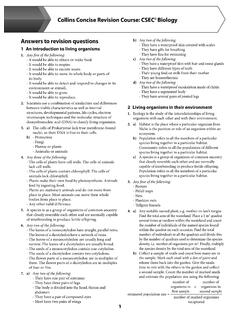Transcription of SAFETY DATA SHEET SODIUM HYDROXIDE - Bunzl CHS
1 Revision date: 25/01/2012 Revision: 02 SAFETY data SHEETSODIUM HYDROXIDESECTION 1: Identification of the substance/mixture and of the Product identifierProduct nameSODIUM HYDROXIDEP roduct number1256 Synonyms; trade namesCAUSTIC SODA ANHYDROUS,PEARL,FLAKES,CAUSTIC SODA, SODIUM HYDROXIDECHEM PURE,CAUSTIC SODA MICROPEARL,CAUSTIC SODA MICROPRILLS FOODGRADE, SODIUM HYDROXIDE MACRO PEARLS, SODIUM HYDROXIDE MICROPEARLS, SODIUM HYDROXIDE MICRO PEARLS FOOD, SODIUM HYDROXIDE CHEMPURUM, SODIUM HYDROXIDE EP PELLETS,CAUSTIC SODA FLK,CAUSTIC SODAMICROPEARL,CAUSTIC SODA PEARL O&G,CAUSTIC SODA MICROPEARL SLYREACH registration number01-2119457892-27 CAS number1310-73-2EU index number011-002-00-6EC Relevant identified uses of the substance or mixture and uses advised againstIdentified usesChemical Chemical Intermediate Detergent.
2 Soaps, Details of the supplier of the SAFETY data sheetSupplierUnivarAquarius House6 Mid Point Business ParkBradfordBD3 7AY+44 1274 1274 Emergency telephone numberEmergency Contact Number(Office Hours)+44 1274 267346 Emergency Contact Number(Outside Office Hours)+441865 407333 Sds 2: Hazards Classification of the substance or mixtureClassificationPhysical hazardsMet. Corr. 1 - H290 Health hazardsSkin Corr. 1A - H314 Eye Dam. 1 - H3181/8 Revision date: 25/01/2012 Revision: 02 SODIUM HYDROXIDEE nvironmental hazardsNot ClassifiedClassification (67/548/EEC or1999/45/EC)C; Label elementsEC number215-185-5 PictogramSignal wordDangerHazard statementsH290 May be corrosive to Causes severe skin burns and eye statementsP234 Keep only in original Do not breathe Wash contaminated skin thoroughly after Wear protective gloves/protective clothing/eye protection/face +P330+P331 IF SWALLOWED: Rinse mouth.
3 Do NOT induce +P361+P353 IF ON SKIN (or hair): Take off immediately all contaminated skin with +P340 IF INHALED: Remove person to fresh air and keep comfortable for +P351+P338 IF IN EYES: Rinse cautiously with water for several minutes. Removecontact lenses, if present and easy to do. Continue Immediately call a POISON Specific treatment (see medical advice on this label).P363 Wash contaminated clothing before Absorb spillage to prevent material Store locked Store in corrosive resistant/.. container with a resistant inner Dispose of contents/container in accordance with national Other hazardsReactions with the following materials may generate heat: Strong acids.
4 WaterSECTION 3: Composition/information on SubstancesProduct nameSODIUM HYDROXIDEREACH registration number01-2119457892-27EU index number011-002-00-6 CAS number1310-73-2EC number215-185-5 SECTION 4: First aid Description of first aid measuresInhalationMove affected person to fresh air at once. Get medical attention if any discomfort date: 25/01/2012 Revision: 02 SODIUM HYDROXIDEI ngestionNever give anything by mouth to an unconscious person. Do not induce vomiting. Do notinduce vomiting. Rinse mouth thoroughly with water. Give plenty of water to drink. Getmedical attention contactRemove affected person from source of contamination. Remove contaminated clothing. Washskin thoroughly with soap and water.
5 Get medical attention immediately. Continue to rinse forat least 15 contactRinse immediately with plenty of water. Remove any contact lenses and open eyelids wideapart. Continue to rinse for at least 15 minutes. Get medical attention immediately. Continueto Most important symptoms and effects, both acute and delayedInhalationSore throat. Coughing. May cause an asthma-like shortness of breath. Upper respiratoryirritation. Tracheobronchitis, pulmonary sensation in mouth. Nausea, vomiting. contactBurning pain and severe corrosive skin damage. Blistering may contactSevere irritation, burning and tearing. Corneal Indication of any immediate medical attention and special treatment neededNotes for the doctorTreat 5: Firefighting Extinguishing mediaSuitable extinguishing mediaThe product is not flammable.
6 Extinguish with foam, carbon dioxide or dry extinguishingmediaDo not use water jet as an extinguisher, as this will spread the Special hazards arising from the substance or mixtureSpecific hazardsToxic gases or vapours. Carbon monoxide (CO). Carbon dioxide (CO2). Advice for firefightersSpecial protective equipmentfor firefightersWear positive-pressure self-contained breathing apparatus (SCBA) and appropriate 6: Accidental release Personal precautions, protective equipment and emergency proceduresPersonal precautionsWear protective clothing as described in Section 8 of this SAFETY data Environmental precautionsEnvironmental precautionsAvoid the spillage or runoff entering drains, sewers or watercourses.
7 Spillages or uncontrolleddischarges into watercourses must be reported immediately to the Environmental Agency orother appropriate regulatory Methods and material for containment and cleaning upMethods for cleaning upDo not touch or walk into spilled material. Collect and place in suitable waste disposalcontainers and seal securely. For waste disposal, see Section 13. Flush contaminated areawith plenty of Reference to other sectionsReference to other sectionsWear protective clothing as described in Section 8 of this SAFETY data SHEET . For wastedisposal, see section date: 25/01/2012 Revision: 02 SODIUM HYDROXIDESECTION 7: Handling and Precautions for safe handlingUsage precautionsAvoid generation and spreading of dust.
8 Avoid contact with skin, eyes and clothing. Avoidinhalation of dust and contact with skin and eyes. Provide adequate ventilation. Contaminatedclothing and shoes must be discarded. Never add water directly to this product as it maycause a vigorous reaction or boiling. Always dilute by carefully pouring the product into Conditions for safe storage, including any incompatibilitiesStorage precautionsStore in tightly-closed, original container in a dry, cool and well-ventilated place. Keep only inthe original container. Store away from the following materials: Acids. unsuitable containers:copper, zinc, aluminium, copper alloy, zinc alloy, aluminium alloy. Avoid contact with classCorrosive Specific end use(s)Specific end use(s)The identified uses for this product are detailed in Section 8: Exposure Controls/personal Control parametersOccupational exposure limitsShort-term exposure limit (15-minute): WEL 2 mg/m WEL = Workplace Exposure LimitIngredient commentsWEL = Workplace Exposure LimitsDNELC onsumer - Inhalation; Long term local effects: 1 mg/m Industry - Inhalation; Long term local effects: 1 mg/m Exposure controlsProtective equipment Appropriate engineeringcontrolsProvide adequate ventilation.
9 Avoid inhalation of dust. Observe any occupational exposurelimits for the product or protectionThe following protection should be worn: Chemical splash goggles. Wear tight-fitting, chemicalsplash goggles or face protectionWear protective gloves. The most suitable glove should be chosen in consultation with theglove supplier/manufacturer, who can provide information about the breakthrough time of theglove material. It is recommended that gloves are made of the following material: Polyvinylchloride (PVC). Rubber (natural, latex).Other skin and bodyprotectionWear appropriate clothing to prevent any possibility of liquid contact and repeated orprolonged vapour contact. Wear rubber measuresProvide eyewash station.
10 Wash hands at the end of each work shift and before eating,smoking and using the toilet. Wash promptly with soap and water if skin becomescontaminated. When using do not eat, drink or protectionIf ventilation is inadequate, suitable respiratory protection must be 9: Physical and Chemical Properties4/8 Revision date: 25/01/2012 Revision: 02 SODIUM Information on basic physical and chemical propertiesAppearancePellets. Flakes. (diluted solution): > 14 10 Melting point318 CInitial boiling point and range1388 - 1390 C @Relative @ 20 CBulk density1100 - 1200 kg/m Solubility(ies)Completely soluble in water. Other informationMolecular weight40 SECTION 10: Stability and ReactivityReactivityThe following materials may react violently with the product: Acids.






